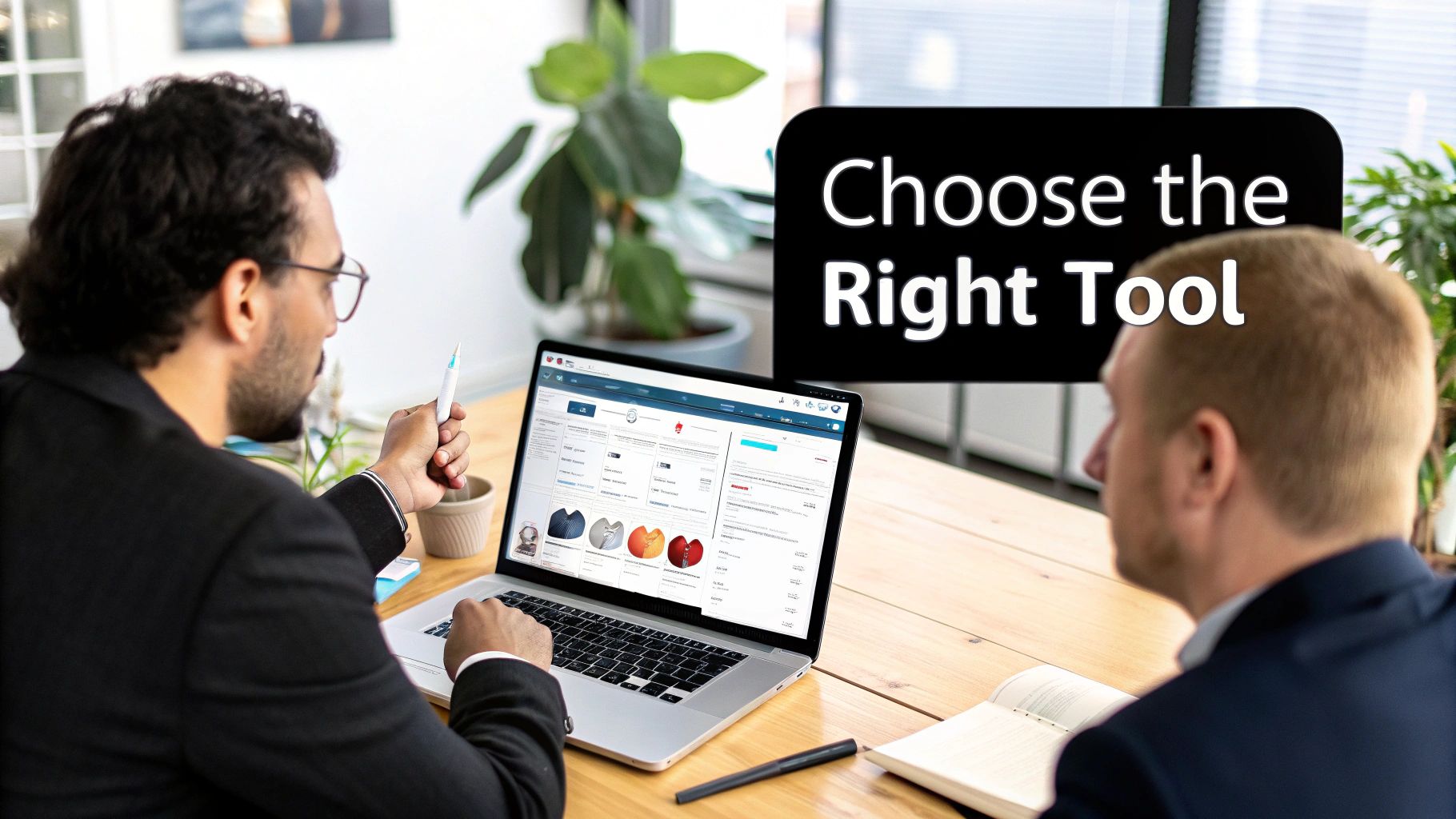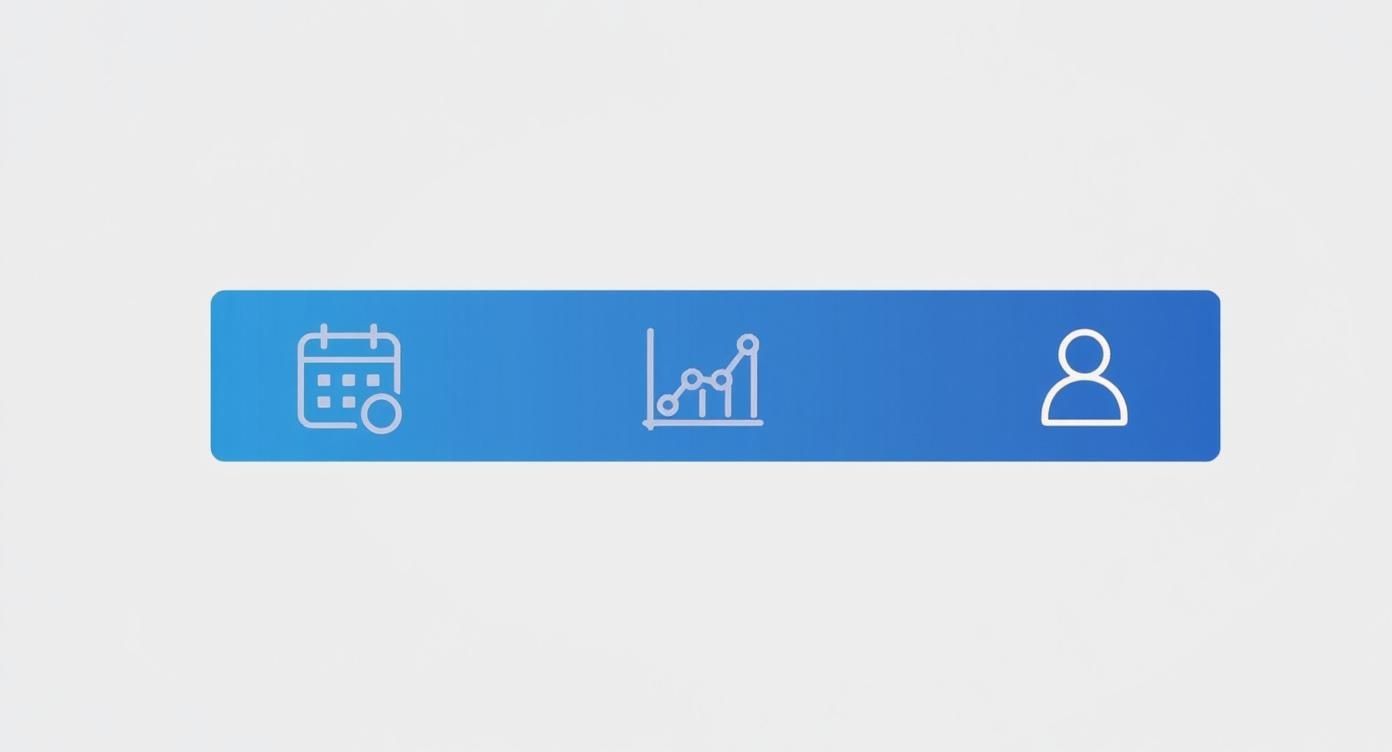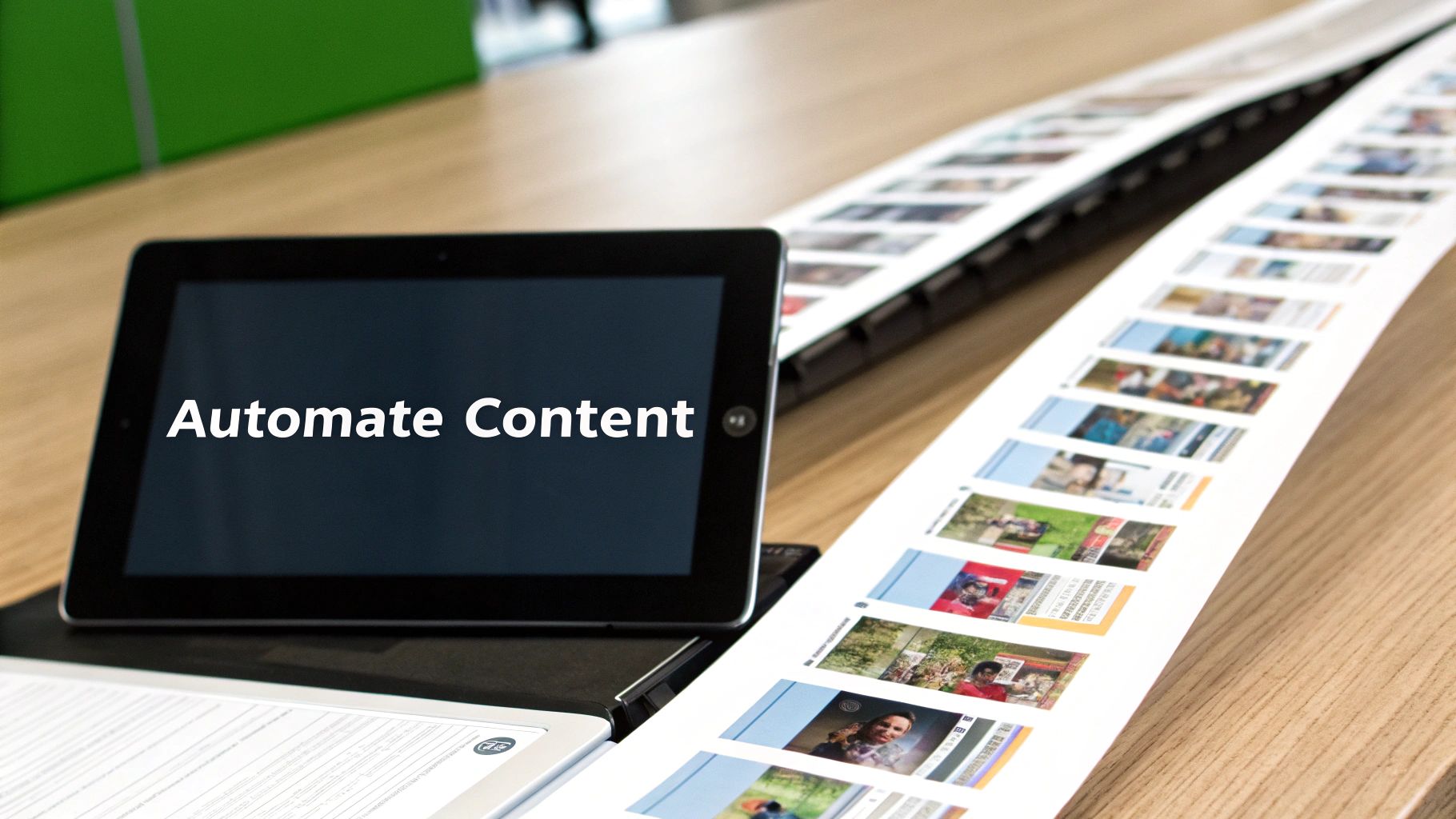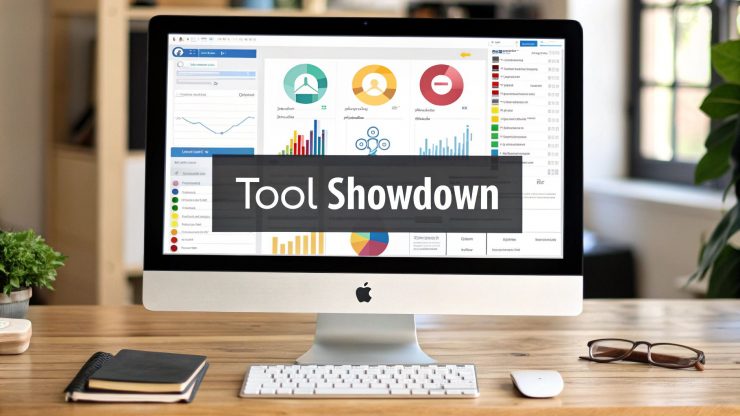Finding the right social media management tool really comes down to one thing: what do you actually need? The perfect platform is simply the one that fits your business goals, team size, and budget.
What works for a solo creator won't work for a massive enterprise. A small business might find everything it needs in Buffer's elegant simplicity, while a larger company will absolutely require the deep, granular analytics from a tool like Sprout Social. This guide is here to help you make that crucial decision.
How to Choose Your Social Media Management Tool
Staring at the endless list of social media management tools can be completely overwhelming. The key is to ignore the flashy feature lists, at least for a moment, and start with your own requirements.
Are you a one-person show just trying to post consistently? Or are you part of a sprawling team with complex approval workflows and client reports? Answering that question is the single most important first step. The right tool isn't just software; it's a force multiplier that can bring order to chaos and turn your daily tasks into a focused, effective strategy.

Key Evaluation Criteria
To make a smart social media management tools comparison, I’m going to judge each platform on four core pillars. These are the exact criteria you should use when doing your own research.
- Scheduling and Publishing: How easy is it to actually plan and schedule your content? I'll be looking at the usability of content calendars, post queues, and any clever automation features.
- Analytics and Reporting: Does the tool give you real, actionable insights, or just a bunch of vanity metrics? Good reporting is what helps you prove ROI and fine-tune your strategy.
- Team Collaboration: How well does it handle teamwork? This is all about approval workflows, setting user permissions, and internal communication features that prevent headaches.
- Integrations and Ecosystem: A social media tool doesn't live on an island. We'll see how well it connects to the other software you use every day, like design tools, CRMs, and deeper analytics platforms.
This space is evolving fast. The global market for these tools is expected to grow by a staggering $54.98 billion between 2024 and 2029, a clear sign of how essential they've become. As this Technavio report shows, that growth is what’s pushing new features like AI-powered content creation and predictive analytics.
With so much happening, focusing on these fundamental criteria will help you cut through the marketing fluff and choose the tool that’s going to make a real difference for your business.
How to Choose the Right Social Media Tool for You
Jumping into a sea of social media tools without a clear plan is a recipe for disaster. It’s like walking into a grocery store starving—you’ll grab a bunch of shiny objects you don't actually need. To pick the right platform, you need a solid framework for your decision. This isn't about finding the tool with the longest feature list; it's about identifying the specific functions that will actually help your business grow.
Think of the following criteria as your personal checklist. Use it to cut through the marketing noise and focus on what genuinely boosts your efficiency and delivers results you can actually measure.
Strategic Scheduling and Publishing
At its core, any social media management tool has to schedule posts. But there's a world of difference between a basic content calendar and a smart, strategic publishing engine. Simply picking a date and time is table stakes—the real magic lies in the advanced features that save you time and boost performance.
When you're looking at scheduling, dig a little deeper for features like these:
- Post Recycling: Does it let you automatically re-share your best evergreen content? This is a game-changer for getting maximum visibility from your most valuable posts without having to do it all manually.
- Optimal Time Suggestions: Some tools are smart enough to analyze when your audience is most active and suggest the best times to post. This data-driven approach takes the guesswork out of timing and can seriously improve your reach.
- Content Queues: Can you load up a queue with content and let the tool publish it automatically based on a pre-set schedule? This is key to maintaining a consistent presence.
These are the features that turn scheduling from a daily grind into a "set it and forget it" strategy. You'll free up hours of your week for more important things, like actually creating great content.
Actionable Analytics and Reporting
Vanity metrics are fun, but likes and follower counts don't keep the lights on. A great tool provides analytics that draw a clear line between your social media activity and real business goals. You need to move past the surface-level numbers and find insights that actually help you make better decisions.
When looking at a tool's analytics, ask yourself:
- Can I easily see which individual posts are performing best?
- Does it tell me what topics and formats are resonating with my audience?
- Can I see how my performance compares to my competitors?
The whole point of analytics is to prove—and improve—your ROI. If a tool can't help you figure out what's working and what's not, it's just a glorified reporting dashboard, not a strategic partner.
Good analytics should help you answer the big question: "Is our social media strategy actually working?" To really nail this, you need to know how to measure social media ROI, which is where the data from these tools becomes incredibly valuable.
Seamless Team Collaboration
If you're working with a team, collaboration features are an absolute must. Without them, you're inviting chaos—think duplicate posts, missed customer messages, and a brand voice that's all over the place. The right tool brings order to that chaos with streamlined workflows that keep everyone on the same page.
Here are the collaboration features that really matter:
- Approval Workflows: A lifesaver for agencies and larger teams. This allows you to set up a process where a manager or client has to approve a post before it goes live, ensuring quality control.
- Role-Based Access: Can you give different people different permissions? For instance, a junior team member might only be able to draft posts, while a manager has the final say to publish.
- Internal Notes and Comments: A dedicated space within the tool to discuss posts or strategy keeps all your communication in one place, avoiding messy email chains.
Robust Integration Ecosystem
Your social media tool doesn't live on an island. Its real power often comes from how well it plays with the other software you use every day. A platform with a strong set of integrations can become the central hub for your entire marketing operation.
For example, connecting to a design tool like Canva makes the content creation process incredibly smooth. Integrating with your CRM, like HubSpot or Salesforce, helps you see exactly how your social media efforts are generating leads and driving sales. The more these tools talk to each other, the more efficient your entire workflow becomes.
A Side-By-Side Tool Comparison
Choosing the right social media management tool is a major decision for your business. With so many platforms out there, doing a direct social media management tools comparison is really the only way to figure out what you actually need. Let's move past the basic feature lists and really dig into four of the biggest names in the game: Buffer, Hootsuite, Sprout Social, and Agorapulse.
My goal here isn't to crown one tool as the absolute "best." It's about matching their specific strengths to what you and your team are trying to accomplish. Whether you're a one-person shop, a growing agency, or a massive enterprise, one of these tools was built to solve your exact problems.
At their core, these platforms all focus on three main jobs: scheduling your content, analyzing how it performs, and helping your team work together seamlessly.

As you can see, a truly great platform needs to nail all three of these areas to be a complete solution. Now, let’s see how each one measures up.
Buffer: The Champion Of Simplicity
Buffer's whole approach is built on making social media scheduling as simple and intuitive as possible. For years, it's been the go-to for small businesses, solo entrepreneurs, and creators who just need a reliable way to keep their social feeds active without getting bogged down in complicated software.
Its signature feature is the post queue. It’s a beautifully simple system: you just drop content into your queue, and Buffer publishes it according to a schedule you’ve already set. For a small e-commerce brand, this is a game-changer. They can sit down for an hour on Monday, load up a week’s worth of product photos, customer reviews, and blog posts, and then completely forget about it.
That simplicity is also its main limitation. Buffer doesn't have the heavy-duty, enterprise-level features you'll find elsewhere. The analytics are great for tracking how individual posts are doing, but you won't get deep competitive analysis or detailed team performance reports that a big agency needs.
Ideal User: The solo marketer or small business owner who cares more about saving time and easy posting than anything else. Buffer makes being consistent feel effortless.
Hootsuite: The All-In-One Command Center
Hootsuite is one of the original players in social media management, and its platform shows that deep experience. It’s most famous for its customizable Streams, which let you monitor multiple social feeds, keywords, and mentions from a single, unified dashboard. It's an incredibly powerful setup for anyone focused on real-time engagement and social listening.
Think about a marketing manager at a mid-sized tech company. They can set up streams to watch for mentions of their brand, their top three competitors, and important industry hashtags. This gives them a live, 360-degree view of their market, letting them jump into conversations or handle customer issues the moment they pop up.
While it’s incredibly powerful, Hootsuite’s interface can feel a bit cluttered for newcomers, and the price can climb quickly for smaller teams. It’s a tool built for power users who need to see and manage everything at once. If you're curious about other options, we dive deeper into platforms in our guide to the best social media scheduling tools.
Sprout Social: The Enterprise Analytics Powerhouse
Sprout Social is aimed squarely at larger teams and enterprise clients who need top-tier analytics, serious collaboration tools, and a slick, polished user experience. Its reporting is easily among the best in the business, giving you detailed insights on everything from post performance to how quickly your team responds to messages.
For example, a large B2B marketing agency would lean heavily on Sprout Social's client approval workflows. A junior team member can draft a post, which is then automatically routed to a manager for review, and finally sent to the client for the final sign-off—all without leaving the platform.
That attention to detail carries over to its analytics. The agency can generate beautiful, white-labeled reports that prove ROI, track campaign results against specific goals, and even benchmark their performance against competitors. Of course, this premium feature set comes with a premium price tag, putting it firmly in the enterprise camp.
Agorapulse: The Engagement And Crm Specialist
Agorapulse has carved out its own space by focusing obsessively on community management and engagement. Its unified social inbox is a masterclass in organization, treating every comment, mention, and DM like a customer support ticket. This makes it a fantastic choice for brands that get a ton of audience interaction.
Imagine a direct-to-consumer brand with a huge, active community on Facebook and Instagram. Their community manager can use Agorapulse to quickly filter the inbox to see unanswered comments, assign conversations to different team members, and use saved replies to answer common questions in seconds.
What's more, Agorapulse builds a simple CRM by creating profiles for everyone who interacts with your brand, complete with their conversation history. This context is invaluable for giving more personal and helpful replies. While its scheduling and analytics are solid, its real magic is in taming social media chaos and turning it into organized, meaningful conversations.
Comprehensive Feature Comparison of Top Social Media Tools
To make this social media management tools comparison even clearer, the table below breaks down the key features and ideal users for each platform. It’s a quick-reference guide designed to help you see at a glance which tool aligns best with your business goals and team structure.
| Feature Category | Buffer | Hootsuite | Sprout Social | Agorapulse |
|---|---|---|---|---|
| Best For | Simplicity & Scheduling | All-in-One Monitoring | Enterprise Analytics & Teams | Community Engagement |
| Ideal User Profile | Solopreneurs, Small Businesses | Social Media Managers | Large Agencies, Corporations | B2C Brands, Customer Support |
| Standout Feature | Effortless Post Queue | Customizable Streams | Advanced Reporting & Workflows | Unified Social Inbox |
| Pricing Tier | $$ | $$$ | $$$$ | $$$ |
Ultimately, the right tool depends entirely on your priorities. Whether you need the straightforward scheduling of Buffer, the comprehensive monitoring of Hootsuite, the deep analytics of Sprout Social, or the engagement focus of Agorapulse, understanding these core differences is the first step to making a smart decision.
Matching Tools To Platform Performance
Picking the right social media management tool comes down to how well its core features line up with each network’s unique demands. Short-form videos shine on TikTok, while detailed articles and document carousels earn traction on LinkedIn.
For B2B lead generation, LinkedIn’s document upload and carousel support often drive more visibility than simple post queues.
Native Feature Support
- Instagram Reels scheduling, complete with trimming and cover selection
- LinkedIn carousel templates versus static image posts
- TikTok auto-captioning and trending audio libraries
When evaluating Instagram tools, look for native Stories and Reels publishing plus first-comment scheduling. On TikTok, seamless posting with automated hashtag suggestions can be the difference between going viral and fading into the feed.
Platform Engagement Insights
Tying tool capabilities to real engagement metrics helps you decide where to invest time and budget.
• TikTok averages 2.5% engagement per post overall and spikes at 7.5% on accounts with fewer than 100,000 followers.
• LinkedIn sees 6.6% engagement on multi-image posts and 5.85% on native documents.
• Facebook boasts over 3 billion monthly users and is rated the top ROI channel by 28% of marketers.
• Instagram closely trails Facebook in ROI importance, thanks to Stories and Reels.
• YouTube ranks third for educational and product-focused content.
Discover more insights about social media marketing statistics on Sprinklr.
| Platform | Key Feature Support | Ideal Tool Profile |
|---|---|---|
| Reels, Stories, Analytics | Sprout Social, Agorapulse | |
| Documents, Carousels, Lead Ads | Hootsuite, Buffer | |
| TikTok | Scheduling, Auto-Captions | Agorapulse, Vista Social |
| Ads, Extensive API Access | Hootsuite, Sprout Social |
Tool Recommendations By Platform
- Sprout Social for in-depth Instagram analytics and reporting
- Hootsuite to track LinkedIn posts, competitor streams, and long-form articles
- Agorapulse’s unified inbox for fast TikTok and Instagram engagement
- Buffer when you need a straightforward post queue across multiple profiles
EvergreenFeed Strengths
EvergreenFeed pairs seamlessly with Buffer, automatically filling open slots with high-performing content from your categorized buckets. Once set up, it recycles your best posts at ideal times—no extra effort required.
Saving hours on manual scheduling means you can focus on crafting fresh content and engaging with your audience.
Who benefits most:
- Professionals sitting on a backlog of blog posts or quotes
- Small teams needing steady activity without extra hires
- Marketers looking to extend post lifespan with minimal upkeep
“EvergreenFeed’s bucket-based model took two hours of weekly scheduling down to minutes, while maintaining engagement levels.” – Social media manager
Finally, align tool training and team processes before rolling out any platform. Even the best scheduling and analytics features fall flat without clear adoption, regular performance reviews, and ongoing support from day one.
Gaining an Advantage With Content Automation
EvergreenFeed steps in as your silent partner, handling the heavy lifting of evergreen content. Instead of manually slotting posts each week, you get a reliable flow of high-value updates without lifting a finger. It’s a simple shift that plugs gaps and keeps your channels active.
Bucket Based Evergreen Scheduling
- Posts are grouped into buckets by topic, format or date.
- The system picks items at random to fill any open slots automatically.
- In just a few clicks, you decide on days, times and bucket priorities.
- Time savings average more than 4 hours weekly for busy teams.
This method dovetails neatly with your main Buffer calendar. Once you’ve set it up, EvergreenFeed quietly fills empty slots. The payoff is a steady posting schedule that consistently engages your audience.
How It Complements Other Tools
EvergreenFeed plugs directly into Buffer. You keep managing core posts there, and let EvergreenFeed handle the evergreen rotation. That means fewer toggles between dashboards and smoother workflows.
“Switching to bucket scheduling cut our weekly scheduling tasks from two hours to ten minutes.” – Social media manager
Integrations include:
- Core Buffer queues and calendars
- Automatic post recycling
- Multi-account support
- Analytics tracking improved reach
You can even replace some planner features entirely, while still reserving space for real-time updates and one-off announcements.
Key Benefits For Marketers
- Set It and Forget It automation cuts repetitive work, freeing up creative energy.
- Bucket Rotation delivers a balanced mix of content with no extra planning.
- Gap Filling ensures daily posts and prevents silent stretches.
- Unified Analytics reveal which recycled pieces perform best over time.
All told, teams report an average 70% reduction in weekly scheduling chores, leading to sharper productivity and stronger audience bonds.
Performance Insights
Over a three-month window, EvergreenFeed users see an average 25% increase in reach and a lift in engagement metrics. The platform tracks bucket performance, so you know exactly which themes resonate.
“After three months, our recycled posts outperformed fresh posts by 15% in reach and saved 10 hours weekly.” – Growth strategist
Screenshot Overview
Here is a screenshot showing the EvergreenFeed dashboard and bucket settings.

You’ll see how buckets link up with Buffer schedules, making it clear how each content category fits into your calendar.
Ideal Use Cases
- Content creators with large article libraries
- Small teams needing consistent activity
- Agencies extending post lifespan with minimal upkeep
If you already maintain blogs or quote collections, EvergreenFeed delivers high ROI. Those craving a “set it and forget it” model will feel the impact right away.
Getting Started Instructions
Sign up for a free account in minutes.
Connect your Buffer profiles and craft your buckets.
Map out posting times by day or content type.
Then step back—and let the system run.
Learn more in our comprehensive detailed guide on automating social media posting workflows today.
To explore how AI-driven tools can further enhance your social media content strategy and automation efforts, you might find valuable insights on resources such as AI-driven content solutions.
Support And Resources
EvergreenFeed offers live chat support and an extensive knowledge base.
You’ll find step-by-step tutorials, email assistance and weekly webinars on advanced scheduling tactics.
- Detailed help articles for setup, buckets and analytics
- Step-by-step API and integration guides
- Case studies with real-world outcomes
- Community forum for tips and feedback
Our blog also shares advanced tips. Many teams combine EvergreenFeed with other AI-driven content solutions to maximize efficiency.
Next Steps
- Audit your existing content and group posts into meaningful buckets.
- Set bucket publishing schedules based on peak engagement times.
- Connect to Buffer and sync calendars for seamless gap filling.
- Monitor analytics and adjust bucket priorities for better performance.
- Join our user community for ongoing tips and best practices.
With EvergreenFeed in place, your manual workflows transform into an automated engine. Start automating content today.
Making Your Final Decision
Choosing a social media management platform goes beyond checking off features. It starts with a clear-eyed look at your own needs and constraints. The framework below turns that self-audit into a confident pick.
Assess Your Requirements
First, map out what matters most to you:
- Budget Limits and Expected ROI
- Number of Users and Approval Layers
- In-House Expertise with scheduling, analytics, or content creation
- Primary Objectives like engagement, lead gen, or customer support
Next, score each item from 1 (low) to 5 (high). Plug those figures into your decision matrix to see where each tool shines. That way, you won’t get distracted by fancy extras that don’t solve your real issues.
For instance, a solo entrepreneur might rank ease of use and time-savings at the top, while a mid-sized agency could prioritize team collaboration and advanced reporting.
Use This Matrix
Below is a distilled view of common scenarios and our top recommendations:
| Scenario | Recommended Tool |
|---|---|
| Solopreneur Focused on Simplicity | Buffer + EvergreenFeed |
| Growing Team Needing Core Scheduling | Hootsuite |
| Large Agency Needing Deep Analytics | Sprout Social |
| Community-Driven Brand Engagement Need | Agorapulse |
This table connects your situation with the platform built for it, cutting through indecision.
“If ease of setup and a fast learning curve are your top priorities, Buffer combined with EvergreenFeed is unbeatable,” notes a seasoned social media manager.
Our approach skips generic pros and cons. Instead, you get actionable advice rooted in real-world use cases.
Next Steps
- Test Drive your top 2–3 picks using free trials.
- Train Your Team on new workflows, content approvals, and analytics dashboards.
- Set Baseline Metrics—engagement rates, posting consistency, response times—then review them quarterly.
- Refine Your Mix by adding EvergreenFeed for automatic evergreen scheduling if you need it.
Each of these steps helps you translate research into results. Follow this path and lock in a social media tool that grows right alongside your goals.
Frequently Asked Questions
Switching tools and weighing features against budgets can feel overwhelming. This FAQ digs into the most common crossroads so you get straight answers—no fluff.
We’ll walk through real scenarios and actionable tips, helping you map features to your team’s size, platforms, and goals.
When you’re ready, dive into hands-on case studies to see these tools in action and sharpen your decision.
When To Switch From Free To Paid Tool
Free plans work—until they don’t. If you find yourself battling more than 3 accounts or spending hours on manual posts, that’s your cue.
Stepping up to a paid tier unlocks:
- Advanced analytics that turn numbers into clear insights
- Collaboration hubs for smooth handoffs between teammates
- Automated posting pipelines to reclaim your calendar
Key signposts include:
- Juggling 3 or more social profiles
- Needing granular ROI reports
- Sharing content queues with clients or co-workers
- Dedicating several hours weekly to scheduling
Choosing The Right Platform Fit
Every management suite has its sweet spots. Some tools go deep on analytics. Others shine at community replies.
For instance, Sprout Social delivers powerful Instagram Story metrics, while Agorapulse makes inbox triage feel effortless. Zero in on the networks that drive your audience.
“A tool’s real worth shows in how it handles your primary channels, not in the total number of networks it lists.”
Most Important Feature For Small Business
Small teams thrive on simplicity. Your focus? Consistent, efficient scheduling.
Look for:
- A visual content calendar with daily and weekly views
- Bucket-based recycling to keep evergreen posts flowing
- Intelligent time-slot suggestions for peak engagement
Nailing these features frees up hours and keeps your feed buzzing without manual intervention.
Additional Best Practices
- Sign up for at least two free trials to compare usability
- Audit your existing content to set up high-impact buckets
- Match each tool’s capabilities to your growth goals before committing
These steps ground your comparison in real needs and ensure you pick the right partner.
Ready to automate evergreen content and free up hours each week? Start using EvergreenFeed completely free today: EvergreenFeed




